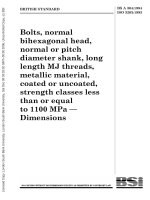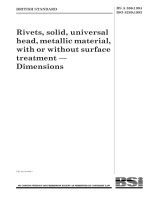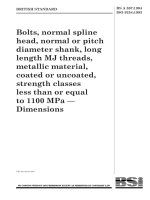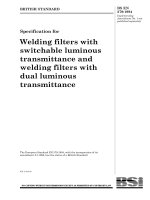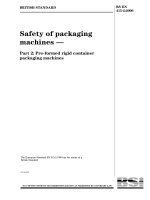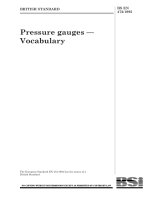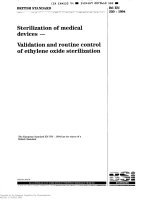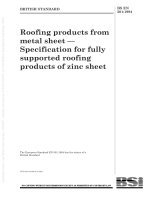Bsi bs en 00678 1994 (2000)
Bạn đang xem bản rút gọn của tài liệu. Xem và tải ngay bản đầy đủ của tài liệu tại đây (282.53 KB, 10 trang )
BRITISH STANDARD
Determination of the
dry density of
autoclaved aerated
concrete
The European Standard EN 678:1993 has the status of a
British Standard
UDC 666.973.6.035.55:620.1:531.75
BS EN
678:1994
BS EN 678:1994
Cooperating organizations
The European Committee for Standardization, under whose supervision this
European Standard was prepared, comprises the national standards
organizations of the following countries:
Austria
Belgium
Denmark
Finland
France
Germany
Greece
Iceland
Ireland
Italy
Luxembourg
Netherlands
Norway
Portugal
Spain
Sweden
Switzerland
United Kingdom
This British Standard, having
been prepared under the
direction of Technical
Committee B/523, was
published under the
authority of the Standards
Board and comes
into effect on
15 March 1994
© BSI 01-2000
The following BSI references
relate to the work on this
standard:
Committee reference B/523
Draft for comment 92/12454 DC
ISBN 0 580 22331 0
Oesterreichisches Normungsinstitut
Institut belge de normalisation
Dansk Standardiseringsraad
Suomen Standardisoimisliito, r.y.
Association franỗaise de normalisation
Deutsches Institut fỹr Normung e.V.
Hellenic Organization for Standardization
Technological Institute of Iceland
National Standards Authority of Ireland
Ente Nazionale Italiano di Unificazione
Inspection du Travail et des Mines
Nederlands Normalisatie-instituut
Norges Standardiseringsforbund
Instituto Portugs da Qualidade
Asociación Espola de Normalización y Certificación
Standardiseringskommissionen i Sverige
Association suisse de normalisation
British Standards Institution
Amendments issued since publication
Amd. No.
Date
Comments
BS EN 678:1994
Contents
Cooperating organizations
National foreword
Foreword
Text of EN 678
National annex NA (informative) Committees responsible
National annex NB (informative) Cross-reference
© BSI 01-2000
Page
Inside front cover
ii
2
3
Inside back cover
Inside back cover
i
BS EN 678:1994
National foreword
This British Standard has been prepared under the direction of Technical
Committee B/523, Prefabricated components of reinforced autoclaved aerated
concrete and lightweight aggregate concrete with open structure. It is the
English language version of EN 678:1993 Determination of dry density of
autoclaved aerated concrete published by the European Committee for
Standardization (CEN).
A British Standard does not purport to include all the necessary provisions of a
contract. Users of British Standards are responsible for their correct application.
Compliance with a British Standard does not of itself confer immunity
from legal obligations.
Summary of pages
This document comprises a front cover, an inside front cover, pages i and ii,
the EN title page, pages 2 to 4, an inside back cover and a back cover.
This standard has been updated (see copyright date) and may have had
amendments incorporated. This will be indicated in the amendment table on the
inside front cover.
ii
© BSI 01-2000
EUROPEAN STANDARD
EN 678
NORME EUROPÉENNE
December 1993
EUROPÄISCHE NORM
UDC 666.973.6.035.55:620.1:531.75
Descriptors: Concrete, aerated concrete, tests, measurements, density, dry density
English version
Determination of the dry density of autoclaved aerated
concrete
Détermination de la masse volumique
sèche du béton cellulaire autoclavé
Bestimmung der Trockenrohdichte von
dampfgehärtetem Porenbeton
This European Standard was approved by CEN on 1993-12-07. CEN members
are bound to comply with the CEN/CENELEC Internal Regulations which
stipulate the conditions for giving this European Standard the status of a
national standard without any alteration.
Up-to-date lists and bibliographical references concerning such national
standards may be obtained on application to the Central Secretariat or to any
CEN member.
This European Standard exists in three official versions (English, French,
German). A version in any other language made by translation under the
responsibility of a CEN member into its own language and notified to the
Central Secretariat has the same status as the official versions.
CEN members are the national standards bodies of Austria, Belgium,
Denmark, Finland, France, Germany, Greece, Iceland, Ireland, Italy,
Luxembourg, Netherlands, Norway, Portugal, Spain, Sweden, Switzerland and
United Kingdom.
CEN
European Committee for Standardization
Comité Européen de Normalisation
Europäisches Komitee für Normung
Central Secretariat: rue de Stassart 36, B-1050 Brussels
© 1993 Copyright reserved to CEN members
Ref. No. EN 678:1993 E
EN 678:1993
Foreword
This European Standard has been prepared by
CEN/TC 177, Prefabricated reinforced components
of autoclaved aerated concrete or lightweight
aggregate concrete with open structure.
This European Standard shall be given the status of
a national standard, either by publication of an
identical text or by endorsement, at the latest by
June 1994, and conflicting national standards shall
be withdrawn at the latest by June 1994.
The standard was approved and in accordance with
the CEN/CENELEC Internal Regulations, the
following countries are bound to implement this
European Standard: Austria, Belgium, Denmark,
Finland, France, Germany, Greece, Iceland,
Ireland, Italy, Luxembourg, Netherlands, Norway,
Portugal, Spain, Sweden, Switzerland and
United Kingdom.
2
Contents
Foreword
1
Scope
2
Normative references
3
Principle
4
Apparatus
5
Test specimens
5.1 Sample
5.2 Shape and size of test specimens
5.3 Number of test specimens
5.4 Preparation of test specimens
6
Testing procedure
6.1 Determination of the volume of
the test specimens
6.2 Determination of the dry mass
of the test specimens
7
Test results
8
Test report
Figure 1 — Sampling scheme
Page
2
3
3
3
3
3
3
3
3
3
4
4
4
4
4
4
© BSI 01-2000
EN 678:1993
1 Scope
5 Test specimens
This European Standard specifies the procedure for
the determination of the dry density of autoclaved
aerated concrete.
5.1 Sample
2 Normative references
This European Standard incorporates by dated or
undated reference, provisions from other
publications. These normative references are cited
at the appropriate places in the text, and the
publications are listed hereafter. For dated
references, subsequent amendments to or revisions
of any of these publications apply to this European
Standard only when incorporated in it by
amendment or revision. For undated references the
latest edition of the publication referred to applies.
EN 679, Determination of compressive strength of
autoclaved aerated concrete.
3 Principle
Test specimens are taken from prefabricated
components. The dry density is determined as the
ratio between the mass of the test specimens after
drying to constant mass at (105 ± 5) °C and their
volume.
4 Apparatus
a) a saw, (for cylindrical test specimens also a
core drill) for cutting test specimens;
b) a straightedge, at least 200 mm long, and
a 0,1 mm-feeler gauge;
c) calipers, capable of reading the dimensions of
the test specimens to an accuracy of 0,1 mm;
d) a ventilated drying oven, capable of
maintaining a temperature of (105 ± 5) °C;
e) a balance, capable of determining the mass of
the test specimens to an accuracy of 0,1 %.
The sample for the preparation of the test specimens
shall be taken in such a manner that it is
representative of the product to be investigated.
NOTE The test specimens may be prepared from prefabricated
reinforced components. Alternatively, they may be taken from
prefabricated unreinforced components of the same mould.
5.2 Shape and size of test specimens
The test specimens shall be prisms, cubes, or
cylinders with a minimum dimension of at
least 50 mm and a volume of at least 0,5 × 10–3 m3
each.
It is recommended that the dry density be
determined on the test specimens used for the
determination of the compressive strength
according to EN 679.
5.3 Number of test specimens
A test set shall consist of three test specimens.
Whenever possible, one test specimen shall be
prepared from the upper third of the component, one
from the middle and one from the lower third, in the
direction of rise of the mass during manufacture
(see Figure 1).
The position of the test specimens in the material,
relative to the rise of the mass, shall be shown by the
numbering.
Alternatively, one single test specimen is sufficient,
if it extends over the full height of the rise of the
mass and if its volume is at least 1,5 × 10–3 m3. The
dry density determined on such a test specimen is
equivalent to the mean value of three individual test
specimens.
5.4 Preparation of test specimens
The test specimens shall be cut by means of a saw
(or a core drill in the case of cylindrical test
specimens).
Plane surfaces shall not deviate from planeness by
more than 0,1 mm. Planeness shall be checked
across the two diagonals of each surface, using a
straightedge and a 0,1 mm-feeler gauge. Deviations
shall be corrected by means of grinding, milling, or
a similar process.
NOTE Preferably, the test specimens should not contain any
reinforcement. If the inclusion of reinforcement cannot be
avoided, the mass and the volume of the reinforcement including
anticorrosion coating shall be considered in the calculation of the
dry density.
© BSI 01-2000
3
EN 678:1993
Figure 1 — Sampling scheme
6 Testing procedure
6.1 Determination of the volume of the test
specimens
Vi
is the volume of the test specimen,
determined according to 6.1, in cubic
metres.
The volume of the individual test specimens is
calculated from their dimensions. For this purpose,
the dimensions shall be measured at different
places to an accuracy of 0,1 mm by means of
calipers. The necessary number of individual
measurements from which the mean dimensions are
calculated depends on the shape, size, and
regularity of the surfaces and shall enable
determination of the volume V of the test specimen
with an error not exceeding 1 %.
The dry density of each individual test specimen, Ôi,
shall be expressed to the nearest 5 kg/m3.
The dry density of the product, Ô, in kilograms per
cubic metre, is defined as the mean value of the dry
densities Ôi of the three test specimens of the test
set:
1
Ô = --- (Ô1 + Ô2 + Ô3 )
3
The dry density of the product, Ô, shall be expressed
to the nearest 5 kg/m3.
6.2 Determination of the dry mass of the test
specimens
8 Test report
The test specimens are placed in a ventilated drying
oven at (105 ± 5) °C until constant mass is attained.
Immediately after removal from the drying oven,
the dry mass, md, of the individual test specimens
shall be determined. The error in determining the
mass shall not exceed 0,1 % of the mass of the test
specimen. The mass of the test specimen is
considered constant if after 24 h of further drying it
has not changed by more than 0,2 %.
7 Test results
The dry density Ôi, in kilograms per cubic metre, of
each individual test specimen i is calculated as
follows:
m di
Ôi = --------i = 1, 2, 3
Vi
The test report shall include the following:
a) identification of the product;
b) date of manufacture or other code;
c) place and date of testing, testing institute and
person responsible for testing;
d) number and date of issue of this European
Standard;
e) shape, size, and relative position of the test
specimens;
f) dry density of each individual test specimen
and mean value;
g) observations on the appearance of the test
specimens.
where:
mdi is the dry mass of the test specimen,
determined according to 6.2, in kilograms;
4
© BSI 01-2000
BS EN 678:1994
National annex NA (informative)
Committees responsible
The United Kingdom participation in the preparation of this European Standard was entrusted to
Technical Committee B/523 upon which the following bodies were represented:
Aggregate Concrete Block Association
Autoclaved Aerated Concrete Products Association
British Masonry Society
British Precast Concrete Federation Ltd.
Department of the Environment (Building Research Establishment)
Federation of Civil Engineering Contractors
Local Authority Organizations
National annex NB (informative)
Cross-reference
Publication referred to
Corresponding British Standard
EN 679:1993
BS EN 679:1994 Determination of compressive strength of autoclaved aerated
concrete
© BSI 01-2000
BS EN
678:1994
BSI — British Standards Institution
BSI is the independent national body responsible for preparing
British Standards. It presents the UK view on standards in Europe and at the
international level. It is incorporated by Royal Charter.
Revisions
British Standards are updated by amendment or revision. Users of
British Standards should make sure that they possess the latest amendments or
editions.
It is the constant aim of BSI to improve the quality of our products and services.
We would be grateful if anyone finding an inaccuracy or ambiguity while using
this British Standard would inform the Secretary of the technical committee
responsible, the identity of which can be found on the inside front cover.
Tel: 020 8996 9000. Fax: 020 8996 7400.
BSI offers members an individual updating service called PLUS which ensures
that subscribers automatically receive the latest editions of standards.
Buying standards
Orders for all BSI, international and foreign standards publications should be
addressed to Customer Services. Tel: 020 8996 9001. Fax: 020 8996 7001.
In response to orders for international standards, it is BSI policy to supply the
BSI implementation of those that have been published as British Standards,
unless otherwise requested.
Information on standards
BSI provides a wide range of information on national, European and
international standards through its Library and its Technical Help to Exporters
Service. Various BSI electronic information services are also available which give
details on all its products and services. Contact the Information Centre.
Tel: 020 8996 7111. Fax: 020 8996 7048.
Subscribing members of BSI are kept up to date with standards developments
and receive substantial discounts on the purchase price of standards. For details
of these and other benefits contact Membership Administration.
Tel: 020 8996 7002. Fax: 020 8996 7001.
Copyright
Copyright subsists in all BSI publications. BSI also holds the copyright, in the
UK, of the publications of the international standardization bodies. Except as
permitted under the Copyright, Designs and Patents Act 1988 no extract may be
reproduced, stored in a retrieval system or transmitted in any form or by any
means – electronic, photocopying, recording or otherwise – without prior written
permission from BSI.
This does not preclude the free use, in the course of implementing the standard,
of necessary details such as symbols, and size, type or grade designations. If these
details are to be used for any other purpose than implementation then the prior
written permission of BSI must be obtained.
BSI
389 Chiswick High Road
London
W4 4AL
If permission is granted, the terms may include royalty payments or a licensing
agreement. Details and advice can be obtained from the Copyright Manager.
Tel: 020 8996 7070.
